I just finished reading Hieroglyph which is a collection of short science fiction stories (which has its own website). The idea behind the book was to present "stories and visions for a better future". That’s nice. What caught my attention was that Neal Stephenson was a contributor and as a fan I wanted to check that out. Stephenson’s story, Atmosphaera Incognita, was about a very tall tower. Bruce Sterling also wrote about this in a fanciful story called simply "Tall Tower", but his story was less technically serious so let’s focus on Neal’s.
Why would tall towers be a thing for optimistic science fiction? Basically when spaceships leave a planet, the difficult thing they must do is break free of the planet’s gravity. It turns out that if you can start your trip to space from a very high altitude, you can reduce the gravity problem substantially. At 35786m above the sea level of the earth, the centrifugal force that wants to fling you out to space perfectly cancels the gravity holding you back. That is a geostationary orbit. The idea of the tall tower is to get as close to that as possible; in Stephenson’s story the tower top was at 20000m altitude. From there, spacecraft can be launched quite easily radically reorienting design priorities for space travel (double payload compared to sea level).
Neal had all kinds of clever ideas for how this could be done. He mostly envisioned a steel structure being assembled on the ground and being jacked into space piece by piece. That’s fine. One of the problems with this is that between 9000m and 16000m our planet’s atmosphere has some very brutal weather called the jet stream. It’s hard to imagine a tower handling that well. Strangely, in the notes, Stephenson credits none other than Jeff Bezos with the idea to stabilize the tower using basically computer controlled aircraft engines. Although imaginative, that sounds pretty precarious to me.
Obviously above 4000m, it’s difficult for normal people to breathe and above 8000m only super human people can avoid dying without bottled oxygen. A little higher up, radiation exposure becomes a problem and it’s always extremely cold. About halfway up Neal’s tower, you really need a spacesuit.
So I read all about that and it seemed cool. Maybe doable, maybe not. I felt like if something as dumb as a tower could be worth investigating, maybe there were other dumb approaches worth looking at. My thought was a mountain.
In all of my travels around the world I’ve been quite impressed by the natural wonder of the natural world, the Grand Canyon, Denali, Iguazu Falls, etc, but what has really impressed me is barbed wire. Yup, that pernicious stuff that mapped from space completely strangles the entire USA in a fine weave. What’s important about that idea is that humans did that. Humans are bad ass when it comes to massive engineering projects. Besides the endless barbed wire (flanking every inch of the equally impressive system of roads), I’ve also seen magnificent engineering works from the tar sands of Alberta to the giant but typical landfill right in San Diego. To me the earth’s mountains are less impressive than man’s ability to flatten them.
Can humans make a mountain? There is no doubt; that is not in question. Just check out these massive mines.
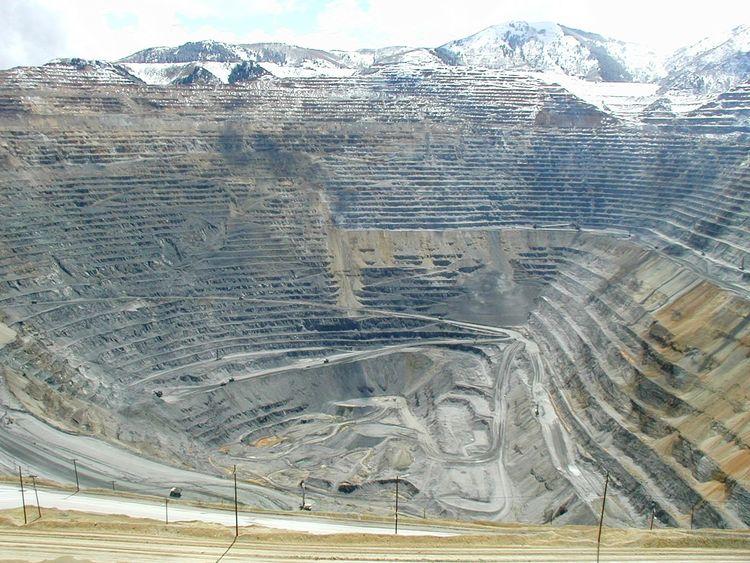
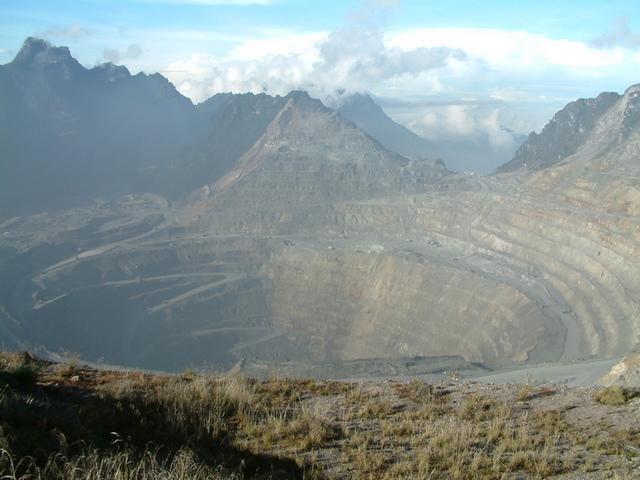
The question is only can we design and build an absolutely enormous mountain far higher than any that naturally exist? I suspect that if humans were suitably motivated (as in this excellent Stephenson story), the answer is yes.
Once I started thinking about this I realized that there are some favorable design elements to this approach. First off is that it would seem to go nicely with mining. If you’re going to dig some absolutely enormous holes to get, say, copper, why not put the tailings into a big pile? Also that jet stream is less of a problem for a mountain than a tower. Instead of requiring tons of energy pumped up to active stabilizing engines, the mountain could have wind turbines at strategic altitudes.
One of the big problems with a tall tower that pokes out of the atmosphere is that it is very hostile to human activity. This is where the autonomous vehicles come in. I keep telling people that autonomous vehicles are not some futuristic technology. They exist today. You can go to your dealer and buy a fully autonomous vehicle today. People think that Waymo or Uber are leading the way in autonomous vehicles. As far as I can tell, the real leaders are Komatsu and CAT.
Check out this video of the awesome work being done by Komatsu for autonomous mine haulage.
If ever there were a technology that could create a mountain, that is it!
Currently they’ve already automated traditional mine hauling trucks, however this design has no operator cab. Perfect for driving around in space!
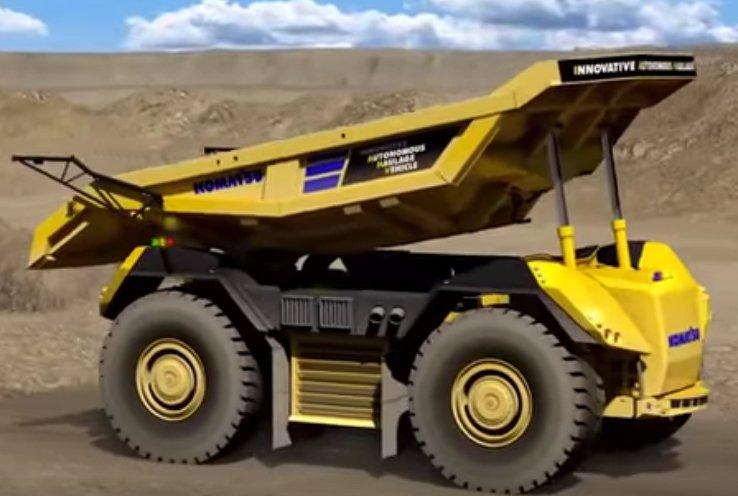
These autonomous mine trucks have tons of advantages for this kind of work. They can go forward or reverse with no preference. They can have complex four wheeled steering, drive, and regenerative braking that senses unstable situations. They can be very precisely positioned. A small team of humans can manage an arbitrary sized fleet. They can be powered by overhead wire or other sliding electrical interface requiring close driving precision (normally associated with rails in city trains). There is no load size that would overwhelm a human pilot’s abilities. Perfect coordination with other vehicles is possible (imagine coordinated pullouts to let an upward and downward pass on the same road).
Hopefully you can visualize how these kinds of machines could build a mountain.
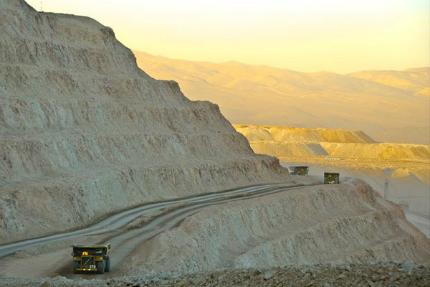
The question is can a big mountain be feasibly synthesized?
What does the engineering say? Well, I’m lazy and about as much of a mining specialist as Neal Stephenson is a high altitude iron worker so this will necessarily be for inspirational purposes only. I’ve started this science fiction off by dreaming up a design I think seems plausible and efficient, but of course this is just a wild guess and smarter analyses could produce much more effective designs.
My favorite civil engineer tells me that the angle of repose can be pretty variable and 2 to 1 (width of base to height) is normal for small slopes but that taller ones may need 3:1. Natural mountains tend to settle in around 5:1 (roughly matching the steepest roads you’re likely to drive).
The design I made is more optimistic. Maybe some technology that can keep a steep slope stable is possible. Let’s pretend that’s true and look at the industrial engineering on a shape like this.

This has the three points circumscribing a triangle with a radius of 1. The height is 2. The volume is a .5 cube. If we built this in the Bolivian high desert at 4000m elevation, we might want a 15,000m high mountain. This would mean that the volume would be about a 4km cube which wolframalpha.com tells me is about 1.7 times the volume of Mount Everest. Seems about right. How hard would it be to move a 4km cube of rocks?
Let’s wildly assume that the hauled rock will be 3000kg/m3. So multiplying that by 4e9m^3 gives 1.2e13kg to haul. These trucks can move up to 400,000kg per load. This divides out into a cool 30 million loads. With enough trucks to allow one to depart full and arrive empty every second, it would take slightly less than one year. To put that in perspective differently, the DOT says that each person in the U.S. requires the movement of 40tons (36,287kg) of freight per year. For 327e6 people this works out to moving roughly the same amount as what I’m talking about.
Is this feasible? Certainly it shows that humans can move that amount of stuff if they’re really motivated. I’m just trying to rough in the concept, but obviously there is a lot of detailed design work to do. Not only do I not have a clear view of all the answers, I can barely understand all of the questions. My favorite civil engineer further points out…
Any (really good) kind of soil will be limited to say 30 psi compressive strength. The pressure at the bottom of the pile will be about 50,000 psi. Good concrete crushes at about 6000 psi. This may be a limiting design variable for mountains - which don’t usually get much above 8000 m. Modern steel of course has a yield strength of upwards of 80000 psi., so some kind of tower may be more feasible.
I don’t exactly know how a pile of dirt fails (landslides?, settling?), but apparently that could be a problem and at that scale it could be pretty serious (earthquakes?, regional weather changes?).
Still, if you can talk optimistically about an absurdly tall tower waving back and forth in the stratosphere, it seems like you should make absolutely sure a tall mountain isn’t a better solution.
Here’s my artist’s rendition of the thing set in the Bolivian Andes (high altitude plus equatorial launch latitude plus copper mining).
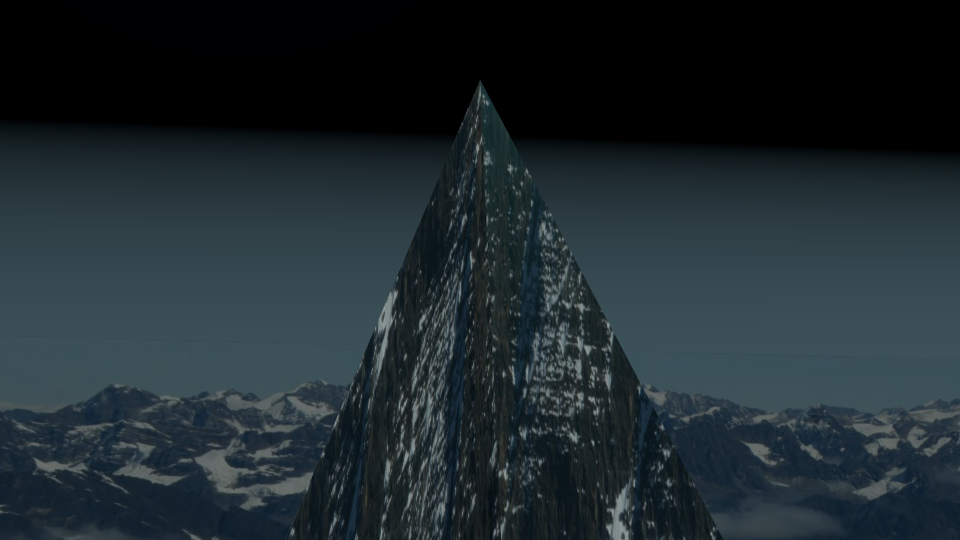
The mountain concept has a lot of benefits. For example, it could be an excellent designed facility for entombing nuclear waste. The Yucca Mountain fiasco reminds us that this is not easy to do. With clear up front access to the base of the mountain I also imagine a geothermal energy source could be engineered. The mountain could be built over a pretty long time horizon and each improvement would incrementally help space travel as the altitude increased.
If you were following the math, you might have noticed I did a 15km high mountain starting at 4000m; what happened to the other 1000m to 20km? It seems like you could combine the mountain idea with the tower idea. Since the geometry and features of the mountain are controlled completely, a vertical shaft as deep as the mountain can be inset. This could contain a tower which could be hoisted during launches. And although the Stephenson/Bezos tower idea seems doomed to technical failure to me, a temporary tower could be hoisted only when conditions were ideal and above jet stream and lightning problems. And this hoisted tower could be actively aligned by thrusters (to clear-line-of-site lasers) like a big vertical snake, powered through cables/pipes from the ground. This would be energy intensive and precarious, but it would extend from the center of the mountain with a spacecraft on top, do the launch, and retract.
Perhaps real astrophysicists could figure out a way to just shoot cargo into space using rail guns lined in the bore of the mountain. This mountain would also make one heck of an observatory. I could go on and on. At the very least, this idea would be a fresh addition to science fiction where hand waving is better tolerated.
2019-05-09 Update
I just learned what a rockoon is. In 1949, the rockoon was a tough engineering challenge. Today, however, I can’t believe a rocket lifted though the atmosphere by a balloon couldn’t be competitive. The main drawback traditionally has been that the balloons can’t be guided. But why can’t computer controls fire props or propellant thrusters on the balloon depending on altitude? Also you can use some very good models for predicting upper atmosphere weather. And if the mission needs to be scrubbed, we know we can land the rocket nicely. Imagine if you wanted to fly an airplane that was sitting on the bottom of the ocean — step one is floating it to the surface. The rockoon is a similar approach and seems like a decent plan to me.
2020-01-30 Update
I just came across a novel approach to launching things into space: a huge centrifuge. The concept is that you spin the rocket very fast with enough energy to throw it, like an ancient sling weapon, to a sufficient altitude to more easily escape gravity. Adding such a facility to my idea of a manufactured mountain would be a perfect combination.